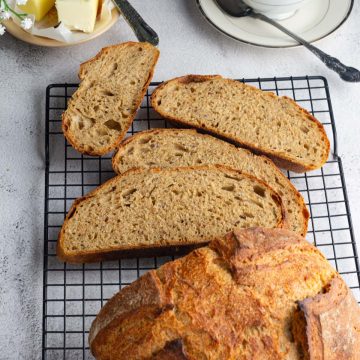
Rye sourdough bread
Rye sourdough bread is a deliciously tangy, hearty loaf with a unique flavor profile that stands out from traditional wheat-based sourdoughs. Made with a combination of dark rye flour and a naturally fermented sourdough starter, this bread boasts a rich, earthy taste and dense crumb, perfect for pairing with cheeses, meats, or simply enjoyed with butter.
Ingredients
- 90 g Active sourdough Starter (~⅓ cup)
- 300 g Bread Flour (2 ½ cups)
- 150 g Dark Rye Flour (~1 ¼ cups)
- 1 tablespoon Olive Oil
- 315 g Water (1 ⅓ cups)
- 25 g Molasses (1 tbsp)
- 1 tablespoon Flax seeds
- 10 g Salt (~1 ½ tsp)
Instructions
Feed the Sourdough Starter
- Feed 30g of your sourdough starter with 30g water and 30g rye or all-purpose flour, keeping it at 100% hydration.
- Let it sit at room temperature for 4-6 hours, ensuring it doubles in size and develops a bubbly surface.
- Perform the float test: drop a small spoonful of starter into a glass of water. If it floats, it's active and ready for baking.
Mix the Dough
- In a large mixing bowl, combine dark rye flour, bread flour, salt, and olive oil.
- In a separate bowl, mix the ripe sourdough starter with water and molasses.
- Stir the wet mixture into the dry ingredients using a dough whisk or spoon until everything is well incorporated.
- Wet your hands and mix until all the flour is hydrated and the dough forms a rough, sticky mass.
Autolyse
- Cover the bowl and let the dough rest for 40-45 minutes.
- This rest period allows the flour to fully absorb the water, activating enzymes that improve dough extensibility and enhance fermentation.
Stretch and Folds
- Perform 4 sets of stretch and folds over the next 3-4 hours, at 30-minute intervals.
- To do this, wet your hands and gently grab one side of the dough, stretch it upward, and fold it over itself.
- Rotate the bowl 90 degrees and repeat the process on all four sides.
- For the fourth set, sprinkle flax seeds over the dough and incorporate them as you fold the dough.
Bulk Fermentation
- After completing the stretch and folds, cover the dough and let it ferment at room temperature for 2-4 hours or until doubled in size.
- Rye dough ferments faster than wheat-based dough, so keep an eye on the dough texture and volume. Ideal temperature for fermentation is 75°F-78°F (24°C-26°C).
Shape the Dough
- Lightly flour a work surface and gently turn out the dough.
- Shape the dough into a round or oval loaf, using floured hands or a bench scraper.
- Place the shaped dough into a floured banneton or a bowl lined with a floured cloth, ensuring it holds its shape.
Final Proofing or Cold Retard
- Cover the dough and let it proof for 2-3 hours at room temperature, or refrigerate for 8-24 hours for enhanced flavor.
- Temperature affects proofing time: warmer environments speed up fermentation, while cooler ones slow it down.
- Always check the dough's texture—well-proofed dough should feel airy, slightly domed, and pass the "poke test," where a gentle press leaves a slight indentation that slowly springs back.
Preheat and Bake
- Preheat your oven to 500°F (260°C), placing a Dutch oven inside to heat.
- Once hot, carefully remove the Dutch oven, place the dough inside, and score the top with a sharp knife.
- Add 2 ice cubes to create steam, cover the Dutch oven with the lid, and bake for 20 minutes.
- Remove the lid and continue baking for 5-6 minutes until the crust is deep brown.
- Check the internal temperature: it should be 200°F (93°C) or higher. The loaf will sound hollow when tapped on the bottom.
Cooling
- Carefully transfer the bread to a wire rack and let it cool completely before slicing.
- Cooling ensures the crumb sets properly and prevents a gummy texture. Slicing too early can result in sticky, underdeveloped bread.
Notes
- If you prefer a milder rye flavor with a lighter crumb, use light rye flour (also called white rye flour) instead of whole rye. Whole rye includes the bran and germ, making the bread more flavorful but also denser.
- To bake directly from the Fridge: Preheat the oven with a Dutch oven or baking stone at 475°F (260°C) for at least 45 minutes. Take the dough out of the fridge, score it, and bake as stated above. There’s no need to bring it to room temperature.
- If your rye sourdough bread is gummy in the center, the cause could be under-baking, excessive hydration, or high enzyme activity. To fix this, bake the bread for a longer period at a lower temperature, aiming for an internal temperature of 205–210°F (96–99°C). This will ensure the bread is fully cooked through. Additionally, it's important to let the bread rest for at least 24 hours before slicing. This resting period allows the crumb to set properly, preventing a sticky or gummy texture when cut.
- Rye dough will be sticky, always use floured or wet hands for handling.
- Also, flour the banneton generously to avoid sticking the dough to the banneton or floured cloth.
📋Nutrition Facts

Nutrition
Calories: 187kcal
Tried this recipe?Let us know how it was!